18 Jul 2024 - {{hitsCtrl.values.hits}}
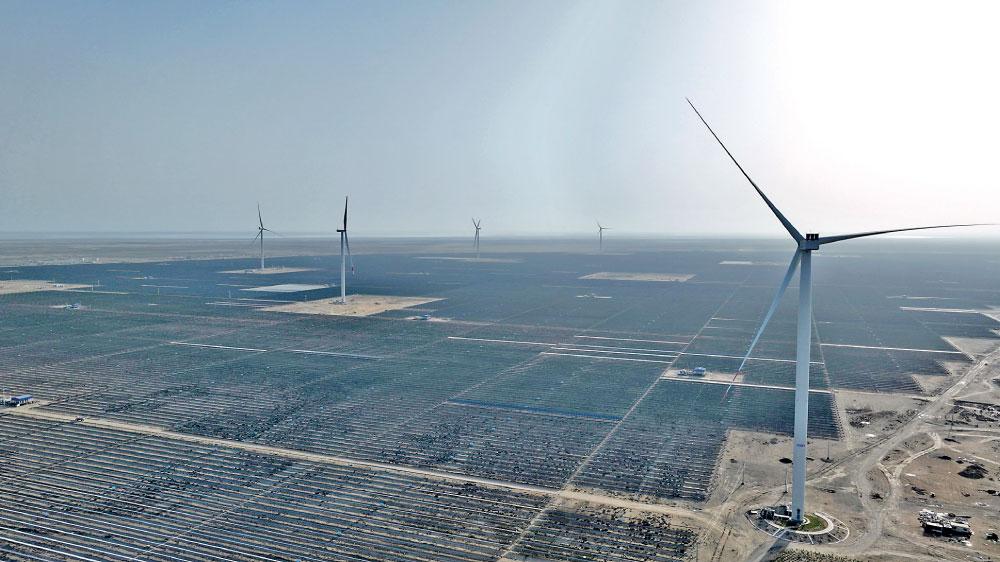
An aerial view of Khavda Renewable Energy Park
By Chamindra Wickramasinghe
Reporting from Ahmedabad, Gujarat, India
On miles and miles of barren marshy land, in the Gujarat state of India, bordering Pakistan, the Earth’s largest renewable energy park is being developed. The solar panels and wind turbines facilitating it shape up in massive manufacturing plants in Mundra, which is also home to the largest commercial port in India. Mirror Business, on a familiarisation tour, witnessed these colossal establishments owned by and named after world’s billionaire Gautam Adani.
His powerhouses’ know-how mingled with the ‘Growth with Goodness’ core philosophical drive, promoting values of courage, trust and commitment, sounds hopeful as the pan-India operator establishes presence in its neighbouring island Sri Lanka.
Gigantic Khavda Renewable Energy Park
It is a giant in its magnitude and stature. Five times the size of the city of Paris and having the extent as much as the city of Mumbai, the Khavda Renewable Energy Park, in Kutch, Gujarat, India, is a venture by Adani Green Energy Limited, India’s largest and one of the world’s leading renewable energy companies.
Upon completion, the park is to be the largest ever power plant in the world, irrespective of the source the energy is generated from. It would be even visible from space.
Under the hot sun, absorbing the sunrays to convert them into electricity, at a glance, rows and rows of thousands and thousands of ground-mounted solar panels are seen at Khavda. Mighty wind turbines are placed at varying distances.
In the deserted landscape, amid heavy dust storms, just 10 kilometres away from the Pakistan border, the facility is developed against the backdrop of India’s ambitious goal of achieving 500-gigawatt non-fossil fuel capacity by 2030 and net-zero emissions by 2070.
 Leveraging sunshine
Leveraging sunshine
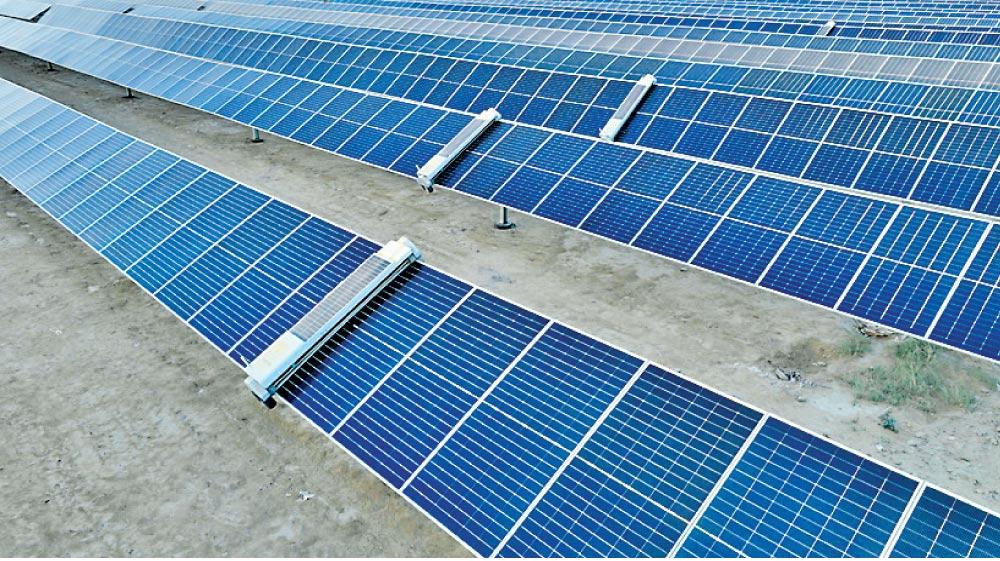
Water-free robotic cleaning system adopted
As the region witnesses ~2,060 kWh/m2 high solar irradiation, in less than one year of its commencement, Khavda could operationalise 2,000 megawatts of solar energy, which accounts to reaching over 6 percent of the 30,000 megawatts mapped out by the company.
Out of Adani Green Energy’s aimed 45-gigawatt renewable energy generation by 2030, the Khavda Renewable Energy Park singly to generate 30 gigawatts – a mix of 26 and four gigawatts of energy, solar and wind, respectively.
A water-free robotic cleaning system is deployed to minimise water consumption for the maintenance of the solar modules in dry Kutch in Gujarat, due to scarcity of renewable water sources. While the extreme heat makes manual execution of the task hard, the system is to save 1,716 million litres of water.
The Khavda Renewable Energy Park has bifacial solar PV modules that generate energy from both sides of the module. The horizontal single-axis tracker systems track the sun to collect more energy.
To make the plant and equipment last long, in the highly corrosive environment, specialised corrosion-resistant coatings are used for the solar module mounting structures and switchyard equipment.
 Wuthering mashes
Wuthering mashes
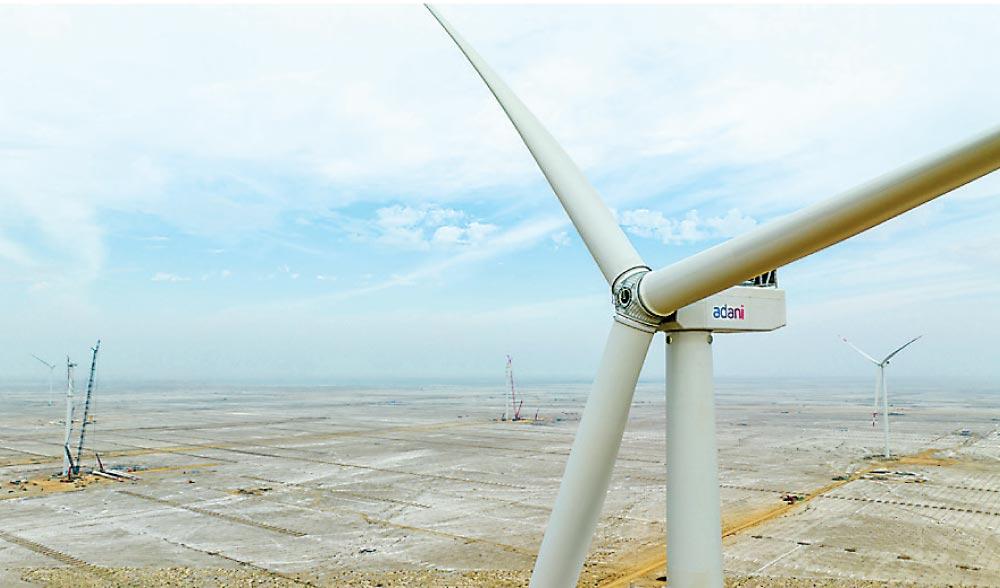
Wind turbines installed at Khavda Renewable Energy Park
With speeds of ~8 meters per second, the park is also one of the best wind resources in India. At the time of the visit, 50 wind turbines were installed, though they were yet to be commissioned.
Equipped with cutting-edge technology, the plant possesses India’s largest onshore wind turbine generator of 5.2-megawatt capacity.
Adani Green Energy would invest about 1.5 trillion Indian rupees in expanding the capacity to generate electricity from solar energy and wind power at Khavda – from two gigawatts currently, to 30 gigawatts, adding five gigawatts every year from next year.
 Made livable
Made livable
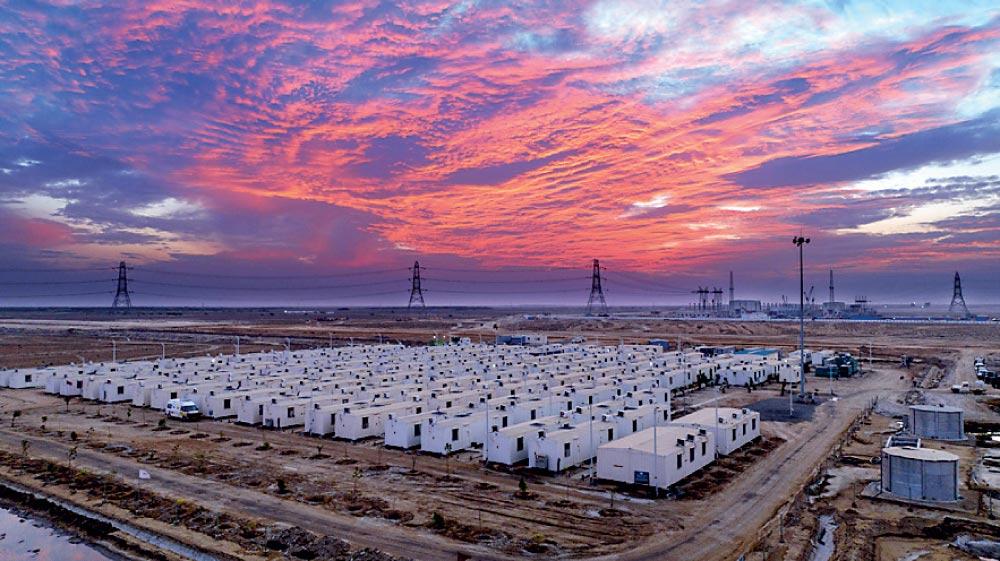
Colonies built for workers on site
Located in the challenging Rann desert of salt marshes, the adjoining lands seen utilised for salt farms, the facility was brought to fruition at a rapid pace.
An area that didn’t even have a pincode and got its name Khavda from a village 80 kilometres away, is made livable for those over 8000 employed there, setting up container homes. Once the uninhabited locality, now has a township that has facilities to treat the sick, repair broken mobile phones, shop for daily essentials, do banking and spend leisure time.
In the parched terrain, the ground water being saline, the water requirement of the project staff is met with desalinated water.
Adani Green Energy is also actively engaged in community development initiatives across several villages, focusing on education, health, women’s empowerment, water conservation and enhancing community infrastructure as part of its environmental, social and governance efforts.
 Legacy 650 by Embraer
Legacy 650 by Embraer

Legacy 650 by Embraer at Ahmedabad Sarda Vallabahai International Airport
The Kauda Renewable Energy Park was reached on board private jet Legacy 650 by Embraer, belonging to Adani, taking off from Ahmedabad Sarda Vallabahai International Airport, an airport managed by Adani Airport Holdings, India’s largest airport infrastructure company. In a little less than an hour’s flight, it landed on Khavda’s own airstrip that was built in just 35 days.
 Robots at work
Robots at work
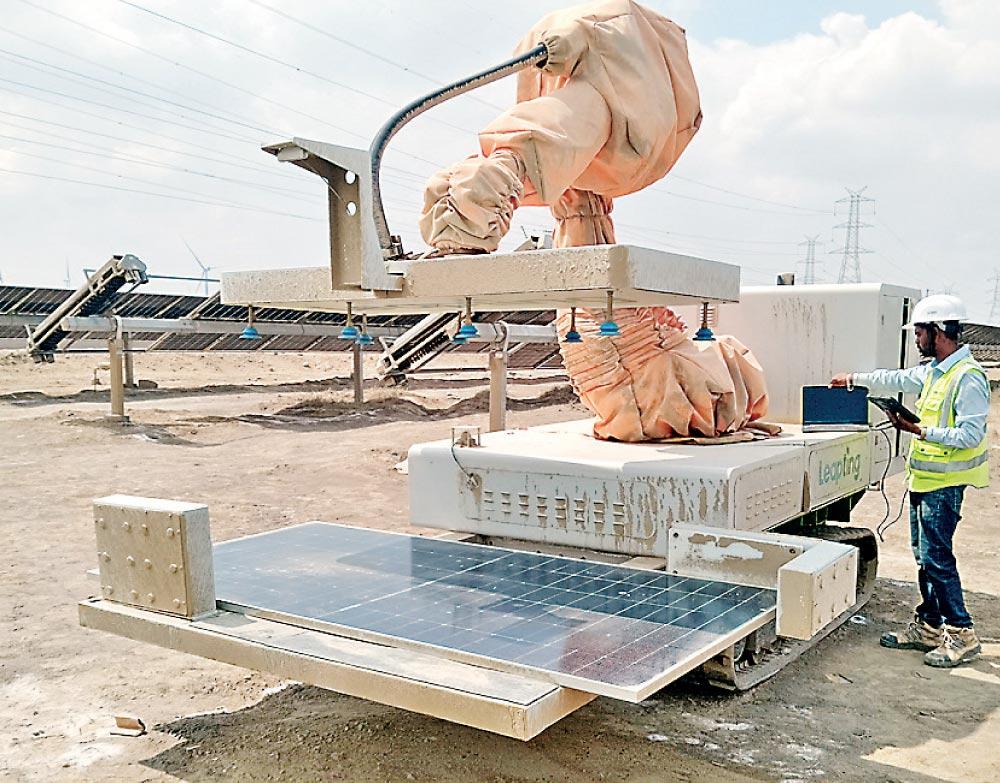
A fully automated robotic solar panel mounting process involves robots to pick solar panels and mount them on stands at Khavda.
 ENOC monitoring
ENOC monitoring
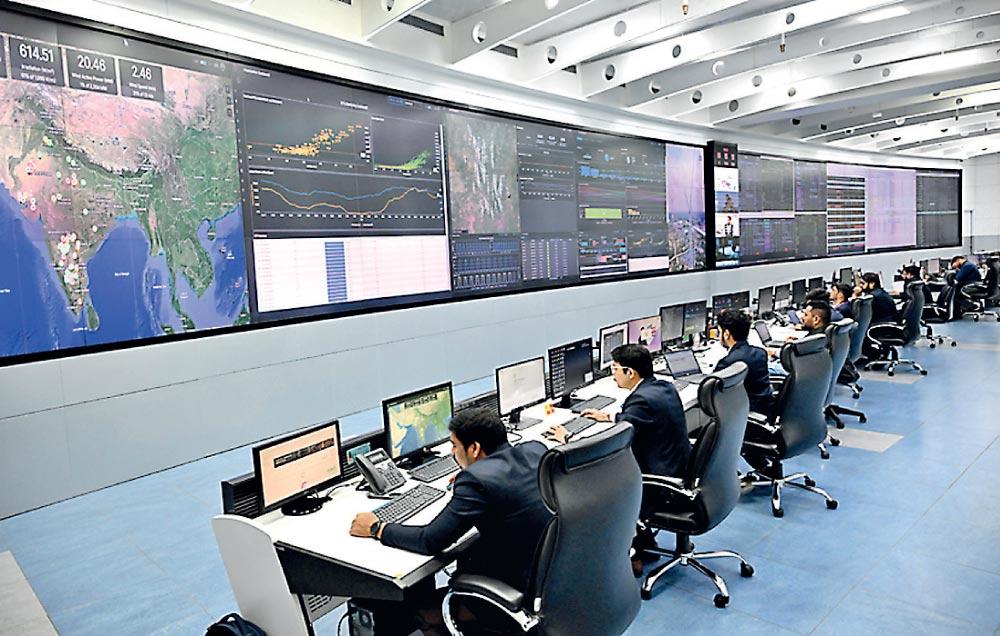
Energy Network Operation Centre
Passing miles of non-arable wastelands, arid and parched, first on a stretch of tarmac road and then on earthern roads, at Khavda, the main operations building is reached. It houses the Energy Network Operation Centre (ENOC), from where all Adani Group’s energy assets, across the country, are monitored.
The state-of-the-art, analytics-driven operations and maintenance platform is connected with cloud technologies and enables real-time monitoring of all its operating plants in 12 states of India.
|
|
|
Khavda’s expected annual contribution include:
|
|
Hopeful Adani projects in Sri Lanka 100% FDI contribution
High energy contribution
Fastest renewable energy development
Government’s cost reduction
Northern province’s regional development
Environmental benefit
Employment generation
Tariff
Forex saving
|
|
Adani Group Chairman Gautam Adani
Adani Group Chairman Gautam Adani, aged 61, is the 17th richest person in the world, according to Forbes World’s Billionaires List 2024, with a net worth of US $ 84 billion. Adani Group is in an ambitious journey towards a low-carbon future, with a commitment to invest US $ 100 billion to ensure that the transition to clean energy is affordable, reliable and accessible to everyone. Its research and development centre initiates renewable innovation to reduce import dependence and propel the ‘Make in India’ initiative. In a recorded speech made to be listened at the Mundra Renewable Energy Experience Centre, Adani Group Chairman Gautam Adani said, “India’s robust infrastructure, economic reforms and dynamic demographics uniquely position us to be leaders in the global renewable energy supply chain.” “Today’s innovations pave the way for tomorrow’s low-carbon future. Together, we are driving a green revolution. Together, we are shaping a sustainable tomorrow,” he said. |
|
Mundra Port in Gujarat
Called the crown jewel of Adani Group, Mundra Port, a manifestation of Gautam Adani’s childhood dream to build a port bigger and better than what he saw at Kandla Port in his youth, is now India’s largest and most advanced commercial port, with the country’s largest container facility. Adani Ports and Special Economic Zone, the largest port developer and operator in India, with 15 ports in its portfolio, runs the Mundra deep draft mother port, where 28 ships can be berthed. Over the 25 years of operations, among numerous assets, it has evolved to possess Mundra Port Coal Terminal, the world’s biggest import coal terminal, a fully mechanised facility that directly sends imported coal to Adani and Tata power plants, enabling a total of 8600 megawatts of coal power generated per year in India. On board a tug boat at Mundra Port, vehicle carrier Divine Ace, sailing under the flag of Panama, was seen being loaded. More than 200,000 cars, all made in India, from Toyotas to Maruti Suzukis, are exported from Mundra to South America, Africa and Europe. Vast amounts of cargo, minimum 15 to 16 billion tonnes, are sent out of Mundra Port per month. |
|
Adani Power Ltd and Adani Energy Solutions Ltd Managing Director Anil Sardana (right) speaks to Sri Lankan journalists during the visit to Adani Corporate House in Ahmedabad
Adani Power Ltd and Adani Energy Solutions Ltd Managing Director Anil Sardana, who also heads Sri Lanka’s wind project, said that for the benefit of the consumers of Sri Lanka, the day the power purchase agreement and implementation agreement are signed with the authorities, “next day you will see the work happening and we will deliver you the entire capacity in our contract.” “Like the way we told the Bangladeshis, despite Covid, the date that we told them, we delivered on that day,” he added. With the tariff offered to Sri Lanka to be fixed for the entire 20-year contract duration, Adani Group is to commit to sourcing 95 percent of the project workforce from Sri Lanka. “We are already telling our people to say make sure that 95% of the workforce to work on these projects, not only operations, … should be locals,” Sardana added. Stating Sri Lankans have been hoodwinked for decades with the dependence on oil-based expensive power generation, the consumer needs to be the focal point of deliverables, instead of the voice of those with vested interests, he opined. “Poor consumer has been taken for a ride for the last 50-60 years with such expensive power,” he said. “Your country has the potential to have solar … can have pumped hydro storage and therefore deliver traceable, green electrons on a very competitive basis. I think you should make the most and then create byproducts like green hydrogen methanol and export them, so that you can have an export surplus and earn some royalty for the benefit of the people.” |
|
Adani Green Energy develops, owns and operates utility-scale grid-connected solar, wind, hybrid and pumped hydro storage renewable power plants. Its operations spread across 12 states of India and consist of 7393 megawatts of solar, a wind capacity of 1401 megawatts and 2140 megawatts of hybrid. Its 10,934 megawatts operational renewable energy portfolio, the largest in India, is to power over 5.8 million homes and avoid 21 million tonnes of carbon dioxide emissions annually. Along with the solar park in northwestern Indian state of Rajasthan, Adani Green Energy runs one of the world’s largest single location solar power plants in the southernmost state Tamil Nadu, which spans an area that is equivalent to about 950 Olympic-sized football fields. The Hindu reported in April that Adani Green Energy has brought “2,848-megawatt renewables capacity on stream in FY24”. Adani Green Energy’s operating portfolio is certified as single-use plastic free, zero waste-to-landfill and water positive for plants with more than 200-megawatt capacity. It has been globally recognised for the sustainability efforts:
|
|
A nacelle at Mundra wind turbine manufacturing plant
|
|
Manufacturing solar modules at Adani plant in Mundra
|
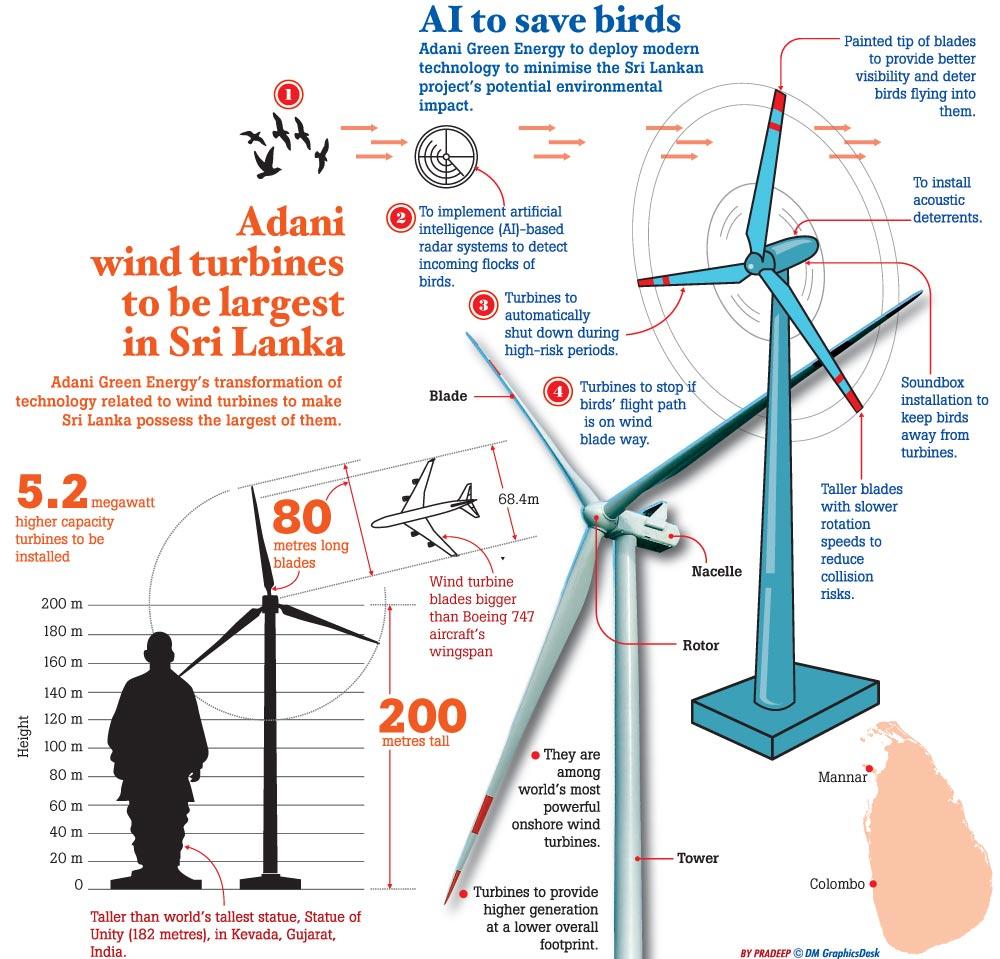
22 Dec 2024 4 hours ago
22 Dec 2024 4 hours ago
22 Dec 2024 6 hours ago
22 Dec 2024 7 hours ago
22 Dec 2024 7 hours ago